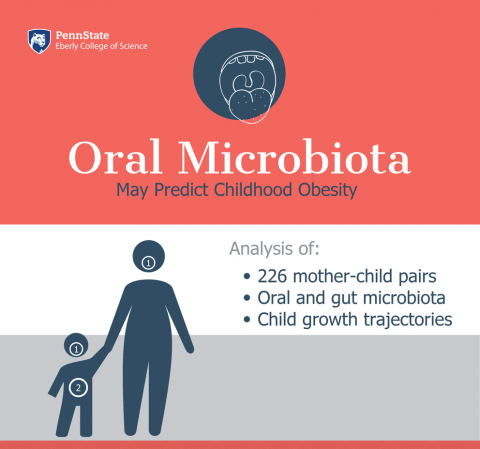
Weight gain trajectories in early childhood are related to the composition of oral bacteria of two-year-old children, suggesting that this understudied aspect of a child’s microbiota — the collection of microorganisms, including beneficial bacteria, residing in the mouth — could serve as an early indicator for childhood obesity. A study describing the results appears Sept. 19 in the journal Scientific Reports.
“One in three children in the United States is overweight or obese,” said Kateryna Makova, Pentz Professor of Biology at Penn State and senior author of the paper. “If we can find early indicators of obesity in young children, we can help parents and physicians take preventive measures.”
The study is part of a larger project with researchers and clinicians at the Penn State Milton S. Hershey Medical Center called INSIGHT, led by Ian Paul, professor of pediatrics at the Medical Center, and Leann Birch, professor of foods and nutrition at the University of Georgia. The INSIGHT trial includes nearly 300 children and tests whether a responsive parenting intervention during a child’s early life can prevent the development of obesity. It is also designed to identify biological and social risk factors for obesity.
“In this study, we show that a child’s oral microbiota at two years of age is related to their weight gain over their first two years after birth,” said Makova.
The human digestive tract is filled with a diverse array of microorganisms, including beneficial bacteria, that help ensure proper digestion and support the immune system. This “microbiota” shifts as a person’s diet changes and can vary greatly among individuals. Variation in gut microbiota has been linked to obesity in some adults and adolescents, but the potential relationship between oral microbiota and weight gain in children had not been explored prior to this study.
“The oral microbiota is usually studied in relation to periodontal disease, and periodontal disease has in some cases been linked to obesity,” said Sarah Craig, a postdoctoral scholar in biology at Penn State and first author of the paper. “Here, we explored any potential direct associations between the oral microbiota and child weight gain. Rather than simply noting whether a child was overweight at the age of two, we used growth curves from their first two years after birth, which provides a more complete picture of how the child is growing. This approach is highly innovative for a study of this kind, and gives greater statistical power to detect relationships.”
Among 226 children from central Pennsylvania, the oral microbiota of those with rapid infant weight gain — a strong risk factor for childhood obesity — was less diverse, meaning it contained fewer groups of bacteria. These children also had a higher ratio of Firmicutes to Bacteroidetes, two of the most common bacteria groups found in the human microbiota.
“A healthy person usually has a lot of different bacteria within their gut microbiota,” said Craig. “This high diversity helps protect against inflammation or harmful bacteria and is important for the stability of digestion in the face of changes to diet or environment. There’s also a certain balance of these two common bacteria groups, Firmicutes and Bacteroidetes, that tends to work best under normal healthy conditions, and disruptions to that balance could lead to dysregulation in digestion.”
Lower diversity and higher Firmicutes to Bacteroidetes (F:B) ratio in gut microbiota are sometimes observed as a characteristic of adults and adolescents with obesity. However, the researchers did not see a relationship of weight gain with either of these measures in gut microbiota of two-year-olds, suggesting that the gut microbiota may not be completely established at two years of age and may still be undergoing many changes.
“There are usually dramatic changes to an individual’s microbiota as they develop during early childhood,” said Makova. “Our results suggest that signatures of obesity may be established earlier in oral microbiota than in gut microbiota. If we can confirm this in other groups of children outside of Pennsylvania, we may be able to develop a test of oral microbiota that could be used in clinical care to identify children who are at risk for developing obesity. This is particularly exciting because oral samples are easier to obtain than those from the gut, which require fecal samples.”
Interestingly, weight gain in children was also related to diversity of their mother’s oral microbiota. This could reflect a genetic predisposition of the mother and child to having a similar microbiota, or the mother and child having a similar diet and environment.
“It could be a simple explanation like a shared diet or genetics, but it might also be related to obesity,” said Makova. “We don’t know for sure yet, but if there is an oral microbiome signature linked to the dynamics of weight gain in early childhood, there is a particular urgency to understand it. Now we are using additional techniques to look at specific species of bacteria — rather than larger taxonomic groups of bacteria — in both the mothers and children to see whether specific bacteria species influence weight gain and the risk of obesity.”
In addition to Makova, Craig, Paul and Birch, the research team includes Jennifer Savage, Michele Marini, Jennifer Stokes, Anton Nekrutenko, Matthew Reimherr and Francesca Chiaromonte from Penn State; Daniel Blankenberg from the Cleveland Clinic; and Alice Carla Luisa Parodi from Politecnico di Milano. INSIGHT (Intervention Nurses Start Infants Growing on Healthy Trajectories) is coordinated through the Penn State Milton S. Hershey Medical Center.
This work is supported by the National Institute of Diabetes and Digestive and Kidney Diseases (NIDDK); the Penn State Eberly College of Science; the Penn State Institute for Cyberscience; the National Center for Research Resources and the National Center for Advancing Translational Sciences of the National Institutes of Health (NIH); and the Pennsylvania Department of Health using Tobacco CURE funds.